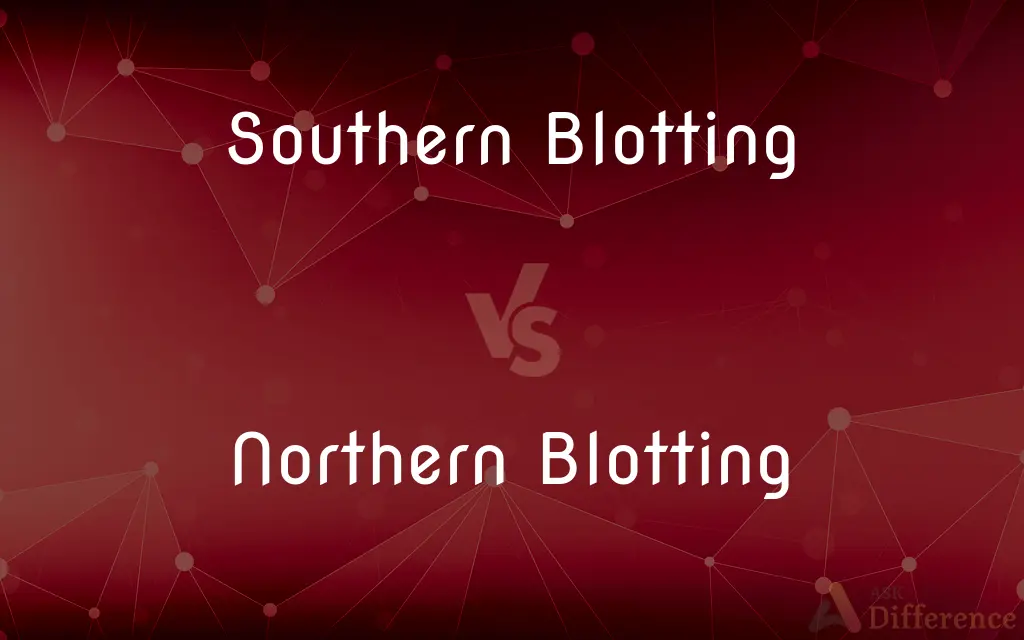Southern Blotting vs. Northern Blotting — What's the Difference?
Edited by Tayyaba Rehman — By Maham Liaqat — Published on September 20, 2024
Southern blotting detects specific DNA sequences within a DNA sample, while Northern blotting is used to analyze specific RNA sequences, reflecting gene expression.

Difference Between Southern Blotting and Northern Blotting
Table of Contents
ADVERTISEMENT
Key Differences
Southern blotting, a technique named after its inventor, Edwin Southern, is a method used in molecular biology to detect the presence of specific DNA sequences within a DNA sample. It involves the separation of DNA fragments by gel electrophoresis, transfer to a membrane, and hybridization with a labeled DNA probe that is complementary to the target sequence. On the other hand, Northern blotting, humorously named in reference to Southern blotting, is focused on RNA. It is used to study gene expression by detecting specific RNA molecules within a sample.
Similar to Southern blotting, RNA is separated by gel electrophoresis, transferred to a membrane, and then hybridized with a labeled probe. However, the focus on RNA provides insights into how genes are being expressed at the mRNA level, which is crucial for understanding the functional aspects of genes in various conditions and treatments.
While Southern blotting provides information about the genetic makeup and DNA sequence variations, Northern blotting offers insights into the dynamics of gene expression under different physiological and pathological conditions. The choice between these techniques depends on whether the study requires analysis of the DNA itself or the expression of genes encoded by that DNA.
The procedural similarities between Southern and Northern blotting include the use of gel electrophoresis for nucleic acid separation and the transfer of these acids onto a membrane for probe hybridization. However, the nature of the nucleic acids analyzed (DNA vs. RNA) and the subsequent implications for research and diagnostics differ significantly. Southern blotting is essential for analyzing genetic information and mutations, while Northern blotting is key for examining how genes are turned on or off in different scenarios.
Another distinction lies in the technical challenges associated with each method. RNA is more prone to degradation than DNA, making Northern blotting potentially more challenging due to the need for rigorous control of RNA quality. Additionally, the interpretation of results from Northern blotting can provide direct evidence of gene expression changes, such as upregulation or downregulation in response to specific conditions or treatments, offering valuable insights into biological processes and disease mechanisms.
ADVERTISEMENT
Comparison Chart
Target Nucleic Acid
DNA
RNA
Main Application
Detecting specific DNA sequences
Analyzing gene expression (specific RNA sequences)
Technique Origin
Named after Edwin Southern
Named humorously in reference to Southern blotting
Probe Type
DNA probe
RNA or DNA probe
Sample Preparation
DNA is fragmented and denatured
RNA is separated without denaturation
Analytical Focus
Genetic information, mutations
MRNA levels, gene expression
Sensitivity to Degradation
DNA is more stable
RNA is more susceptible to degradation
Implications
Used in gene mapping, paternity testing, mutation detection
Used to study gene expression, regulation, and response to conditions
Compare with Definitions
Southern Blotting
Involves DNA fragment separation and hybridization.
Researchers use Southern blotting to map the gene responsible for a trait.
Northern Blotting
Offers insights into gene expression and regulation.
Northern blotting can reveal how gene expression changes during development.
Southern Blotting
Used in gene mapping and diagnostics.
Southern blotting is applied in paternity testing to match DNA samples.
Northern Blotting
Analyzes specific RNA sequences to study gene expression.
Northern blotting shows the upregulation of a gene in cancer cells.
Southern Blotting
A technique for detecting specific DNA sequences.
Southern blotting can identify a mutation associated with a genetic disorder.
Northern Blotting
Separates RNA molecules for hybridization analysis.
It is used to measure mRNA levels after drug treatment.
Southern Blotting
Detects DNA size and sequence variation.
It can differentiate between wild-type and mutant alleles in a genome.
Northern Blotting
Essential for understanding mRNA levels.
Researchers assess gene activation in response to environmental stress via Northern blotting.
Southern Blotting
Provides a snapshot of DNA presence or absence.
Detecting a viral DNA sequence within a host genome.
Northern Blotting
Reflects functional gene activity.
Identifying the expression of a specific gene in different tissue types.
Common Curiosities
Can Southern and Northern blotting be used together?
Yes, they can be complementary, with Southern blotting analyzing DNA sequences and Northern blotting assessing how those genes are expressed.
How does Northern blotting differ from Southern blotting in terms of application?
Northern blotting focuses on RNA, particularly mRNA, to analyze gene expression patterns, unlike Southern blotting, which targets DNA.
Is there a technique for protein analysis analogous to Southern and Northern blotting?
Yes, Western blotting is used to detect specific proteins, serving a similar role for protein analysis as Southern and Northern blotting do for DNA and RNA.
How do probes work in Southern and Northern blotting?
Probes in both techniques are labeled sequences that can hybridize to complementary sequences, but they target DNA in Southern blotting and RNA in Northern blotting.
What is the purpose of Southern blotting?
Southern blotting is used to detect and study specific DNA sequences in a sample, useful for gene mapping and mutation analysis.
Why is RNA more challenging to work with in Northern blotting?
RNA is inherently more unstable and prone to degradation than DNA, requiring stringent handling and processing conditions.
Can Northern blotting indicate the quality of RNA in a sample?
Yes, the integrity and quantity of RNA bands can provide information about the sample’s RNA quality.
What insights can Northern blotting provide that Southern blotting cannot?
Northern blotting offers insights into the dynamic process of gene expression, including how specific genes are regulated and respond to various conditions.
How do researchers choose between Southern and Northern blotting?
The choice depends on the research question: Southern blotting is selected for DNA analysis, while Northern blotting is chosen for examining RNA and gene expression.
What advancements have supplemented Southern and Northern blotting?
Techniques like PCR (Polymerase Chain Reaction) and real-time PCR have supplemented these methods for more sensitive and quicker analysis of DNA and RNA.
Share Your Discovery

Previous Comparison
Last Will vs. Living Will
Next Comparison
Pecans vs. WalnutsAuthor Spotlight
Written by
Maham LiaqatEdited by
Tayyaba RehmanTayyaba Rehman is a distinguished writer, currently serving as a primary contributor to askdifference.com. As a researcher in semantics and etymology, Tayyaba's passion for the complexity of languages and their distinctions has found a perfect home on the platform. Tayyaba delves into the intricacies of language, distinguishing between commonly confused words and phrases, thereby providing clarity for readers worldwide.













































